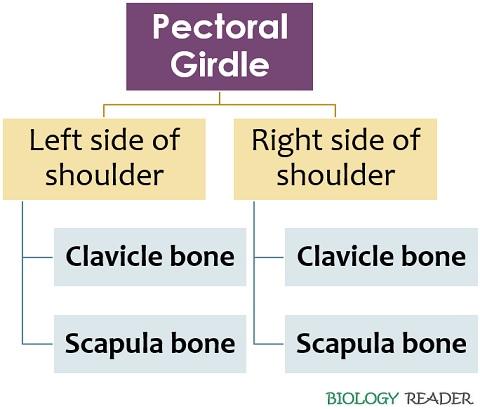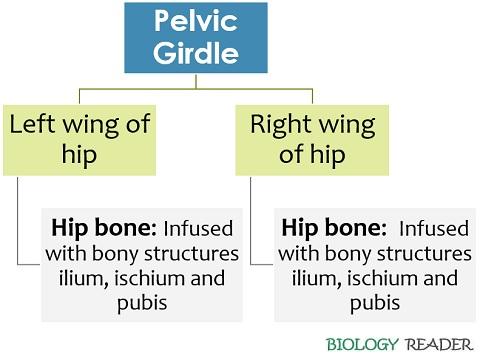The difference between pectoral and pelvic girdle is mainly due to the following factors like the type of bones contributing to the formation, association of bones and articulations. Collar bone (clavicle) and the shoulder blade (scapula) are the two types of bones contributing to shoulder muscle or pectoral girdle formation. Hip or coxal bones solely contribute to the structure of pelvic girdle.
In the human body, the left and right pectoral girdles lie far apart and function independently. Conversely, the left and right pelvic girdles unite to form a strong foundation for the upper and lower body movement.
Pectoral girdle supports forelimbs’ bones (humerus, ulna, radius, carpels, meta carpels and phalanges). In contrast, pelvic girdle anchors the hindlimbs’ bones (femur, patella, tibula, fibula, tarsals, metatarsals and phalanges).
We will discuss the key differences between the pectoral and pelvic girdle along with the comparison chart in this context. You will also get to know the definition and components of both the girdles.
Content: Pectoral Vs Pelvic Girdle
Comparison Chart
| Properties | Pectoral Girdle | Pelvic Girdle |
|---|---|---|
| Alternative name | Shoulder girdle | Hip girdle |
| Meaning | It is the shoulder bone, which articulates each bone of forearms with the axial skeleton's sternum | It is the hip bone, which articulates each bone of hind limbs with the axial skeleton |
| Bones | Clavicles and scapulas are the bones forming the pectoral girdle | Coxal bones contribute to the structure of pelvic girdle |
| Association of bones | The left and right shoulder bones (clavicles and scapulas) are not highly united | The left and right hip bones are highly united with the bones (sacrum and coccyx) and form a bowl-shaped structure (Pelvis) |
| Homology in bones | Both clavicle and scapula are dissimilar | It consists of innominate coxal or hip bones |
| Weight of bones | The bones of the pectoral girdle are lighter | The possesses hard coxal bones |
| Sub-compartments | Absent | The coxal bones comprise three sub-compartments or bony components (ilium, ischium and pubis) |
| Articulation with the axial skeleton | Articulation with the axial skeleton | It associates with the sacrum and coccyx bones of the axial skeleton |
| Cavity | Glenoid cavity (shallow) | Acetabulum cavity (deep) |
| Joint | The sternoclavicular joint is the portion where the pectoral girdle's clavicle bone meets manubrium of the sternum | The sacroiliac joint is the portion where the ilium meets with the sacrum of the axial skeleton |
| Articulation with appendicular skeleton | It helps in the articulation of the forelimb bones | It helps in the articulation of the hind limb bones |
| Functions | It supports and gives flexibility to the forelimbs so that we could perform tasks like holding and lifting things | It supports the upper body's weight and provides rigidity to the hindlimbs so that we could stand, run, jump etc. |
Definition of Pectoral Girdle
It is defined as the connecting bone, which unites the bones of forelimbs to the axial skeleton. Pectoral girdle has two bones, namely clavicle and scapula. In humans, the left and right pectoral girdle can function independently because they both do not act as a unit, i.e. the left and right pectoral girdle are not joined firmly. The axial skeleton coordinates the functioning of both the pectoral girdles.

Clavicle: It is a collar bone, which appears S-shaped. It lies in an anterior side of the shoulder. It is the longest bone, which lies horizontally. Clavicle laterally supports the scapula, as the lateral end of the clavicle is joined to the posterior ridge of the scapula (coracoid process) via coracoclavicular ligament. It possesses three regions like the sternal end, acromial end and shaft.
- The sternal end is the triangular, medial portion of the clavicle, which associates with the manubrium.
- An acromial end is the clavicle’s lateral region, which associates with the acromion of the scapula.
- The shaft is the thick middle portion, which is highly prone to the fractures.
Scapula: It is also termed as shoulder blade or blade bone, which lies a posterior side of the shoulder. Scapula possesses two ridges, namely the coracoid process and spine of the scapula.
- The coracoid process is present under the clavicle’s lateral end.
- The scapula’s spine or acromion process is a ridge protrudes out of the scapula’s upper portion.
There are three depressions called fossae, in which two fossae (supraspinous fossa and infraspinous fossa) are present posteriorly, and one fossa (subscapular fossa) is present towards the anterior side. Fossae increase the surface area for the forelimbs attachment.
Definition of Pelvic Girdle
It is defined as the bone connecting the hindlimbs to the axial skeleton. Unlike pectoral girdle, it only comprises hip bones or coxal bones. In humans, there are two hip bones. Coxal bones serve as an attachment point of both the hind limbs.

Unlike the pectoral girdle’s bones (function independently), the pelvic girdle’s coxal bones unite firmly to form a weight-bearing and immobile structure. Thus, it serves as a strong base above which the upper body rests. The left and right coxal bones inferiorly attach to the two other bones (sacrum and coccyx).
- Sacrum: It is a triangular bone present at the base of the last lumbar vertebra, and it connects the two wings of the pelvic girdle.
- Coccyx: It is a tail-bone that comprises of rudimentary vertebrae and present at the base of the sacrum.
- Bony components: It includes ilium, ischium and pubis contribute to the structure of hip bone.
- Ilium: It forms the coxal bone’s superior portion.
- Ischium: It constitutes the coxal bone’s posteroinferior region.
- Pubis: It makes up the local bone’s anterior portion.
Sacroiliac joint, sacrococcygeal symphysis, pubic symphysis are the three components that unite all the four bones (two coxal bones, sacrum and coccyx) and contributes to the bowl-shaped structure (Pelvis). There are two sacroiliac joints between the coxal bones (ilium) and sacrum. Sacrococcygeal symphysis links sacrum to the coccyx. Pubis symphysis attaches the pubis bodies of the left and right coxal bones.
Key Differences between Pectoral and Pelvic Girdle
- The pectoral girdle is the shoulder bone, which articulates each bone of forelimbs (humerus, ulna, radius, carpals, metacarpals and phalanges) with the sternum the axial skeleton. The pelvic girdle is the hip bone, which articulates each bone of hind limbs (femur, patella, tibula, fibula, tarsals, metatarsals and phalanges) with the sacrum portion of the axial skeleton.
- Clavicles and scapulas are the two bones present in two halves (left and right side) of the pectoral girdle, which appears dissimilar, light in weight and lies far apart. Coxal bone is a single bone infused with ilium, ischium and pubis components present in two halves (left and right wings) of the pelvic girdle, which appears similar, seems hard and lies in close vicinity.
- The coxal bones of pelvic girdle comprise of three bony structures, namely ilium, ischium and pubis. In contrast, the clavicles and scapulas of the pectoral girdle do not comprise such bony structures.
- Pectoral girdle associates with the sternum or ribcage of the axial filament through sternoclavicular joint, while pelvic girdle associates with the sacrum of the axial skeleton via a sacroiliac joint.
- Pectoral girdle articulates the forelimb bones into the shallow glenoid cavity, whereas pelvic girdle articulates the hind limb bones into the deep acetabulum cavity.
Conclusion
Therefore, we can conclude that both pectoral and pelvic girdle are the bones which connect the appendicular skeleton to the axial skeleton. The appendicular skeleton includes the bones of forelimbs and hindlimbs, whereas the axial skeleton consists of the vertebral column’s bones. Thus, girdle forms the ball and socket joint for the forelimbs and hindlimbs to facilitate movement and locomotion.